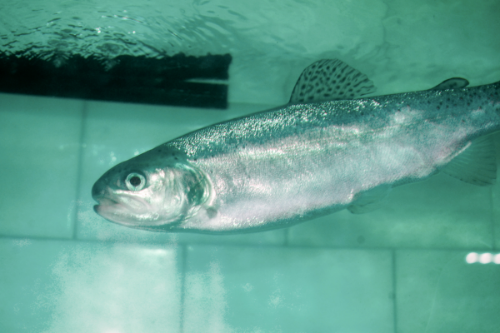– Karelia is one of Russia's leaders in rainbow trout farming. However, cage farming often involves stress and diseases in the fish. Antibiotics, the main instrument of disease control, affect the fish itself, humans - consumers of fish products, as well as water bodies. The trend in world science is to search for supplements of natural origin to promote the resistance of the animals to adverse factors. Our attention was drawn to the bio-supplement dihydroquercetin," said Nadezhda Kantserova, Project Manager, Senior Researcher at the Ecological Biochemistry Laboratory of the Institute of Biology KarRC RAS.
Dihydroquercetin (DHQ) is a naturally occurring antioxidant. It is extracted on an industrial scale from Siberian larch stump wood, a logging waste. Dihydroquercetin has applications in the food industry and in medicine, including for the prevention of COVID-19. Producers of the dietary supplement also claim that DHQ can be useful in fish farming, but there is no data in the scientific literature on its use in trout farming. Karelian scientists resolved to fill this gap.
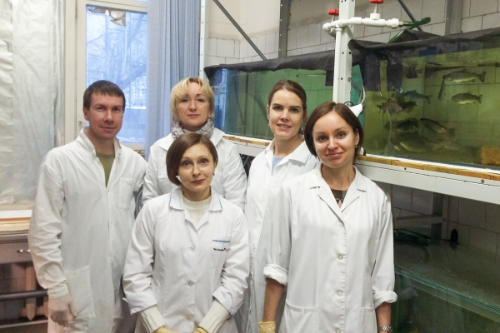
Participants of the study - researchers from the Institute of Biology KarRC RAS: Aleksey Parshukov, Irina Sukhovskaya, Lyudmila Lysenko, Maria Kuznetsova, and Nadezhda Kantserova
The study was supported by a grant from the Russian Science Foundation and included experiments in cages and aquariums. One of the cage experiments was conducted in a trout farm in 2017-2018. Fish were divided into two groups: the control and the experiment. The former were fed a standard diet, while the latter received DHQ with the feed. It is noteworthy that unfavorable circumstances happened in both years of the experiment: in 2017 there was an outbreak of a bacterial infection in the farm, and in 2018 the summer was very hot, the water temperature rose above 24 degrees, whereas trout is a cold-loving species for which the optimum temperature is 14-18 degrees.
– As a result of the experiment, we saw a decrease in the death rate in the group that received DHQ with food. During periods with normal conditions, there was no difference between the two groups. But when stress factors occurred - disease, temperature rise, etc. - DHQ clicked into action. This means it can be regarded as a modulator of the body's defensive capacities, - said Nadezhda Kantserova.
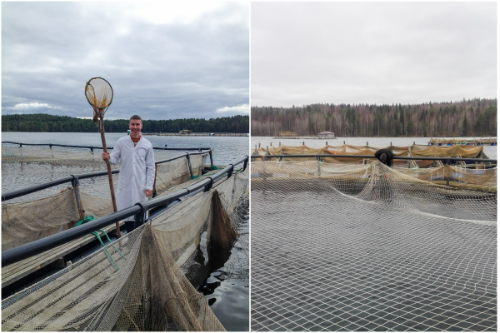
Alexei Parshukov, Senior Researcher at the Laboratory of Plant and Animal Parasitology of the Institute of Biology KarRC RAS, during the experiment in the trout farm
Scientists tested whether DHQ stimulated growth in the fish. This was an effect declared by the supplement's manufacturer. Some changes in this respect appeared at the biochemical level: trout from the experimental group had a higher expression level of the myosin gene, the main structural protein of skeletal muscles, while the accumulation of lipids in muscles, on the contrary, was reduced. In general, the fish receiving DHQ were not larger than the rest.
While the cage experiment was mainly focused on monitoring macroindicators - fish survival, growth and resistance to adverse factors, the purpose of the aquarium experiment was to search for the molecular mechanisms behind the effects of DHQ on trout organism. The results of this work were published in the international journal Animals.
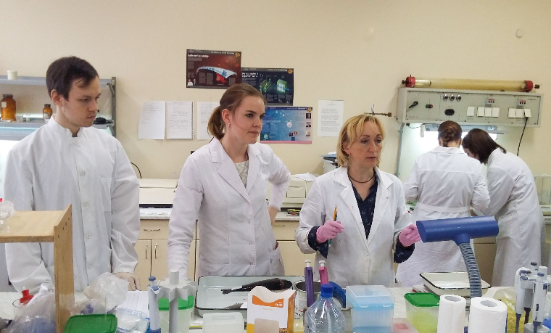
Researchers working in the lab
The experiment was conducted in the aquarium facility of the Institute of Biology KarRC RAS. 160 fish were divided into four groups and placed in eight aquariums. Fish of the first group were kept on a standard diet at 14 °С. Fish of the second group were fed a standard diet, but the water temperature in the aquariums was raised by 1 °C per day up to 23 °C. Fish of the third and fourth groups were also kept at 14 °C and at elevated temperature, but they received DHQ with their food. In addition, scientists encountered an unforeseen factor: all trout turned out to be infected with parasitic flatworms of the genus Gyrodactylus. The infection rate proved to be lower in the group that received DHQ with food. At the end of the aquarium experiment, liver samples were taken from the fish for transcriptome analysis.
The transcriptome is the complete set of matrix RNA molecules in a cell. A transcript is an RNA molecule transcribed from the corresponding gene or DNA segment. Some genes are transcribed (expressed) only under certain circumstances. If these circumstances arise and the organism needs to "switch on" a particular gene, an RNA molecule is synthesized from the DNA matrix (this process is called transcription), which will then passes the genetic information on to the protein. Proteins perform essential functions in the body, from construction to defense, and it is proteins that ultimately effect the functions of the "switched on" gene.
– That is, the set of genes (genome) is the same in any cell of the organism, but the set of transcripts (transcriptome) that are synthesized from them is different, depending on specific conditions. Transcriptome analysis provides information about the state of the organism, organ or tissue under the specific conditions of the given moment in time. The results of the analysis give us reason to say that certain genes are expressed in organisms of the given group under the influence of some factor. So in our experiment, we did such an analysis examining the effects of three factors: an increase in water temperature, infection, and the effect of the supplement," the scientist explained.
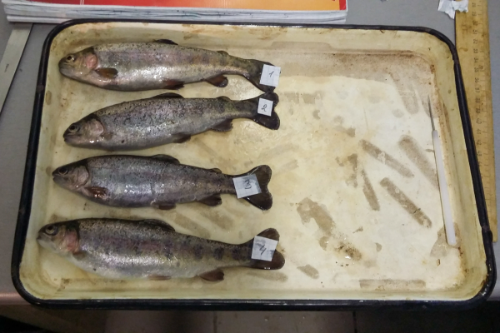
Study object – rainbow trout
Transcriptome analysis was carried out by scientists from Petrozavodsk in collaboration with the St. Petersburg State University and the Limnological Institute of the Siberian Branch RAS (Irkutsk).
— When the fish were exposed to elevated temperature, we saw a classic response: chaperone genes - heat shock proteins - were activated. But the activation of chaperone protein genes was more intensive in the fish that received DHQ with food - more chaperones were synthesized. Less cholesterol and other sterols were produced in the presence of DHQ. In the case when the temperature was not raised, there was no difference at the transcriptome level between the groups supplemented and not supplemented with DHQ.
As a result, the scientists confirmed their conclusion from previous experiments: DHQ has no effect on normal physiology, but if a stress factor appears (disease, temperature rise, hypoxia, etc.), the supplement can help the organism to cope with it. Thus, DHQ supplementation reduces the need for antibiotics in trout farming without any toxic effects on humans or the environment.
Summing up the outcomes of five years of work, Nadezhda Kantserova thanked her colleagues and noted that the well-coordinated work and mutual support of all participants of the study were keys to the project's success.




